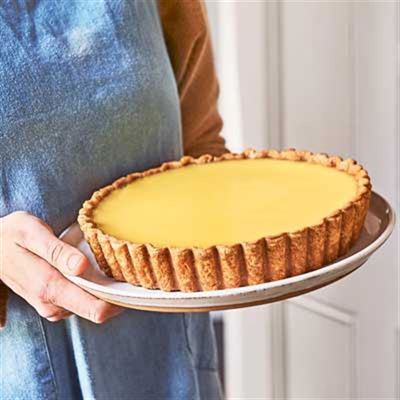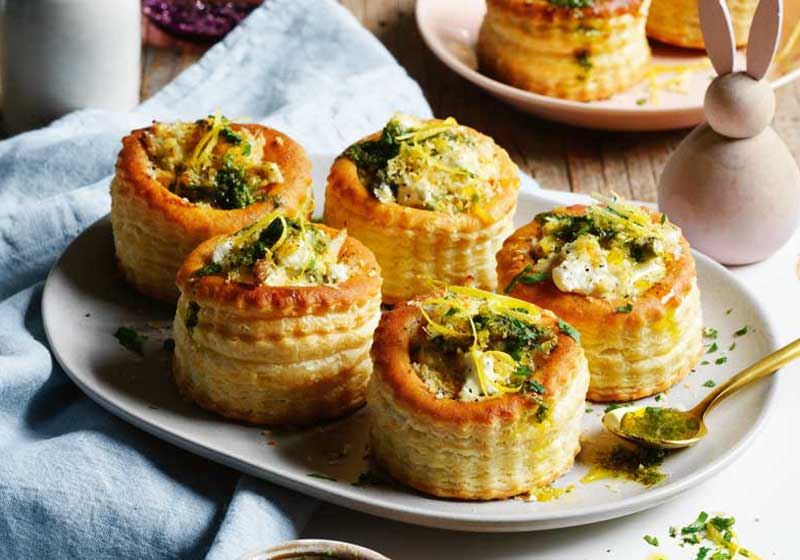Lemon Cream Tart - Recipe by Natalie Paull
6

Ingredients
Brisee butter crust:
175 g plain flour
130 g unsalted butter, cold and sliced into small tiles
3 g fine sea salt
60mL iced water
Lemon custard filling
6 eggs
20 g egg yolk (from one egg, reserving the white to seal the tart shell)
4 best lemons
240 g caster sugar
300mL cream
1/4 tsp salt flakes
Method
Brisee butter crust:
Lightly toss the flour, butter tiles and salt together in a wide mixing bowl and chill for 30 minutes. Then break and flake the butter pieces between your fingers while tossing with the flour until the butter pieces are the size of a thick thumbnail. The flour will have taken on just the faintest yellow hue. Scatter the water over the flour/butter mix and lightly toss through – it won’t look like anything has changed with the mix but the smear (fraisage) will bring the dough together.
Tip the crumbly dry flour/butter mix onto your work surface and make a pile which we will call pile A. Imagine pile A is sitting at 4 o’clock on a clock face. Using the taut heel of your palm, smear the dough 20 cm away from the pile, across the bench to 11 o’clock to form pile B. The smearing will start to cohere the dough. Employ your non-smearing hand to stop the back end of the dough from scattering back away from the starting pile.
Drag all of pile B back to 4 o’clock and smear it again. Do this four to eight times (kitchen temperature dependent – it will take far less time in a warm kitchen) until the dough does two things: the VERY dry shaggy patches disappear and the dough forms an almost cohesive mass when softly squeezed together. It’s okay if a few dry, shaggy bits remain.
Wrap loosely in plastic wrap and firmly squeeze into a flat, fat disc – this will be the final step in bringing the dough together, and the dough will feel like quite stiff playdough. Chill the dough overnight to hydrate fully.
To roll, bring the dough to cool and pliable temperature (around 15–30 minutes at room temperature) and place it on a lightly floured surface. Press the dough out a little with the palm of your hand to ease it into the start of rolling. This helps to prevent large cracks. Give the dough one or two short pressured rolls with the pin before lifting and moving the dough 90 degrees, making the rolls longer as the dough circle widens. Dust underneath the dough at regular intervals to prevent sticking.
For a 24 cm round × 4 cm tart tin, roll out the dough to a 35 cm circle, about 4 mm thick. Trim, then gently lift and flop the dough into the tin.
If you’re making smaller tarts and need to re-roll, stack the offcuts and press together. Rest for 10 minutes and re-roll once only. The shrinkage gets worse with each re-roll.
Working in sections, tuck the dough right into the corner and against the side of the tart tin to prevent air pockets, then use your fingers to push the excess dough off the top. For individual tins, cut circles slightly larger than the tins and line in the same way, cutting off the excess.
If lining a classic pie dish, loosely position the side dough on the lip, then press the excess off. Take a wooden skewer and deeply press lines along the lip at around 1 cm intervals, radiating out.
Freeze for at least 1 hour before blind baking.
To blind bake, preheat the oven to 200 C.
Cover the frozen dough with a large piece of aluminium foil (dull side down), tucking it snugly into the corner of the tin. Fill the foil liner with approximately 750 g caster sugar, then place the tart shell on a heavy baking tray. Reduce the heat to 170 C and bake for 1 hour until the crust base is a fully realised tan-brown colour. If the base crust is still a little pale, remove the foil and return to the oven for 5 minutes – watching closely until the crust base reaches peak crisp and brown.
Lemon filling and baking:
Fill a 25 cm wide saucepan with 5 cm of water, place on the stovetop and bring to a low simmer. Choose a stainless-steel bowl to sit on top that is slightly wider than the pan so the bottom of the bowl won’t touch the water.
Into that bowl (before placing it over the saucepan), place the 300 g of egg and the yolk. Place the egg white in a separate small bowl and lightly whisk to break it up – you’ll use this to seal the tart shell later.
Finely grate the zest of 1 lemon, then juice all the lemons, strain and weigh 180mL of juice. Add the zest into the juice and set aside.
Add the sugar into the egg bowl and hand whisk together until combined, but not frothy. Whisk in the lemon juice/zest, then whisk in the cream and salt until fully combined. Place the bowl on the double boiler, gently whisking often until the mix reaches 60 C – around 10–12 minutes. The custard will get a little thicker, the foam will dissipate and the custard will turn a more sunshiny yellow.
Remove the bowl from the heat and pour the filling through a fine sieve into a measuring jug. Discard the zest. If you have a little froth on the top you can spoon this off, but it’s not vital. Set the filling aside at room temperature while you prepare the crust.
Preheat your oven to 120 C and adjust the oven racks – set one in the lower part of the oven and remove all the ones above it, allowing space to manoeuvre a jug in easily to pour the filling in later.
Place the blind-baked crust, still in the tin, on a shallow baking tray. If there are any large cracks or dipped sides, massage a little leftover dough to a soft paste consistency and gently patch any large fissures – taking care not to press hard and break the crust. Then meticulously brush the inside of the tart with the whisked egg white.
Return the baking tray and crust to the oven and bake for 3 minutes to seal the crust before filling. With the tart still in the oven, and your eye on where the crust edge is lowest, carefully and slowly pour the custard into the crust to fill as far as you can. If your jug, when tilted, is too big for the oven, switch to a smaller cup to scoop in the last of the mix. Don’t overfill, or the filling will cascade between the crust and tin.
Bake for 40–50 minutes and then check in 5-minute increments until there is a 7 cm diameter centre of quivering, thick shakey filling in the middle of the tart. This wobbly centre will continue to cook and set firmer upon cooling. Turn the oven off, keep the door closed and leave for 5 minutes. The wobbly centre should have set firm and feel like the most delicate bouncy custard trampoline when touched lightly with your fingertips. Leave another 5 minutes if you think it’s still a bit too wobbly.
Remove from the oven and allow to cool at room temperature for at least 1 hour (longer for deeper tarts) before cutting the first slice. You can also chill to hasten the setting (and eating).
Cracks along the crustline will appear if overcooked or over time, if you keep the tart for a few days. To repair, a little smear across the crack towards the crust with a small palette knife will cover it up.
Tart-eating temperature: Cool to room temperature for 1 hour, then chill for 30 minutes (unchilled is a little too tremulous). Or chill further for creamier, stable slices.
Dust with icing sugar and brûlée or leave it pure sunshiny yellow.

Photo Credits: Photographer: © Rochelle Eagle 2024








